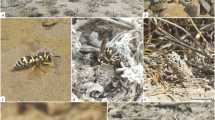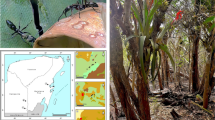Abstract
We describe the nest construction and architecture, and the prey collection and storage behavior ofOdynerus dilectus Saussure, a ground-nesting eumenid wasp of North America that exclusively utilizes weevil larvae of the genusHypera as prey. This species may have potential as a biological control agent of alfalfa and clover weevils in the genusHypera because of its rapid collection of weevil larvae, its gregarious nesting habit, and the apparent ease with which individuals can be transplanted. Other European congeners have many similar characteristics. The potential for adverse interactions betweenO. dilectus andBathyplectes curculionis (Thomson), a parasite ofHypera, is discussed.
Résumé
La construction du nid deOdynerus dilectus Saussure est décrite ainsi que la récolte et la conservation des proies. Cette euménide de l'Amérique du Nord fait son nid dans le sol et utilise exclusivement les larves d'un charançon du genreHypera comme proie. Cette espèce peut présenter des potentialités comme agent de lutte biologique contre les charançons de la luzerne et du trèfle à cause de ses facilités de récolte rapide des larves, de son nid grégaire et de la facilité apparente du transport de ce prédateur. D'autres congénères de l'Europe ont beaucoup de caractéristiques analogues. Il est discuté des possibilités d'antagonisme entreOdynerus dilectus etBathyplectes curculionis (Thomson), un parasite ichneumonide deHypera.
Similar content being viewed by others
References
Adlerz, G. — 1970. Iakttagelser över solitära getinger. —Ark. Zool., 3, 1–63.
App, B. Z. &Manglitz, G. R. — 1972. Insects and related pests. In: Alfalfa Science and Technology (C. H. Hanson, ed.) —Am. Soc. Agron., Madison, Wis., 527–554.
Bristowe, W. S. — 1948. Notes on the habits and prey of twenty species of British hunting wasp. —Proc. Linn. Soc. Lond., 160, 12–37.
Fabre, J. H. — 1924. Souvenirs Entomologiques, Deuxième Série., —Librairie Delagrave, Paris.
Ferton, C. — 1923. La Vie des Abeilles et des Guêpes. —E. Chiron, Paris.
Grandi, G. — 1935. Contributi alla conoscenza degli Imenotteri Aculeati. XV. —Boll. Inst. Entomol. Univ. Bologna, 8, 27–121.
Grandi, G. — 1961. Studi di un entomologo sugli Imenotteri Superiori. —Boll. Inst. Entomol. Univ. Bologna, 25, 1–659.
Hagen, K. S., Bombosch, S. &McMurtry, J. A. — 1967a. The biology and impact of predators. In: Theory and Practice of Biological Control, (C. B. Huffaker &P. S. Messenger, eds.). —Academic Press, New York, 93–142.
Hagen, K. S., Viktorov, G. A., Yasumatsu, K. &Schuster, M. F. — 1976b. Biological control of pests of range, forage, and grain crops. In Theory and Practice of Biological Control (C. B. Huffaker &P. S. Messenger, eds.). —Academic Press New York, 397–442.
Huffaker, C. B., Messenger, P. S. &DeBach, P. — 1971. The natural enemy component in natural control and the theory of biological control. In Biological Control (C. B. Huffaker, ed.). —Plenum Press New York, 16–67.
Huffaker, C. B., Simmonds, F. J. &Laing, J. E. — 1976. The theoretical and empirical basis of biological control. In Theory and Practice of Biological Control (C. B. Huffaker &P. S. Messenger, eds.). —Academic Press, New York, 41–78.
Iwata, K. — Evolution of Instinct: Comparative Ethology of Hymenoptera. —Amerind Publ. Co., New Delhi, India, 535 p.
Janvier, H. — 1956. Hymenopterous predators as biological control agents. —J. Econ. Entomol., 49, 202–205.
Krombein, K. V. — 1979. SuperfamilyVespoidea. In: Catalog of Hymenoptera in America north of Mexico, Vol. 2 (K. V. Krombein, P. D. Hurd, Jr., D. R. Smith &B. D. Burks eds.). —Smithsonian Inst. Press, Washington, D. C., 1469–1522.
Linsley, E. G. &Michener, C. D. — 1942. Notes on some Hymenoptera from the vicinity of Mt. Lassen, California. —Pan-Pac. Entomol., 18, 27–29.
Messenger, P. S., Wilson, F. &Whitten, M. J. — 1976. Variation, fitness, and adaptability of natural enemies. In: Theory and Practice of Biological Control (C. B. Huffaker &P. S. Messenger eds.). —Academic Press, New York, 209–231.
Nielsen, E. T. — 1932. Sur les habitudes des Hyménoptères aculéates solitaires. II. [Vespidae, Chrysididae, Sapygidae, Mutilidae] —Entomol. Meddel., 18, 84–174.
Parker, F. D. — 1966. A revision of the North American species in the genusLeptochilus [Hymenoptera: Eumenidae]. —Misc. Publ. Entomol. Soc. Am., 5, 151–229.
Parker, F. D. &Bohart, R. M. — 1968. Host-parasite associations in some twig-nesting Hymenoptera from western North America. Part II. —Pan-Pac. Entomol., 44, 1–6.
Spradbery, J. P. — 1973 Wasps. —Univ. of Washington Press, Seattle, 408 pp.
Turnbull, A. L. &Chant, D. A. — 1961. The practice and theory of biological control of insects in Canada. —Can. J. Zool., 39, 697–753.
Author information
Authors and Affiliations
Additional information
Retired.
Rights and permissions
About this article
Cite this article
Bohart, G.E., Parker, F.D. & Tepedino, V.J. Notes on the biology ofOdynerus dilectus [Hym.: Eumenidae], a predator of the alfalfa weevil,Hypera postica [Col.: Curculionidae] . Entomophaga 27, 23–31 (1982). https://doi.org/10.1007/BF02371934
Issue Date:
DOI: https://doi.org/10.1007/BF02371934




